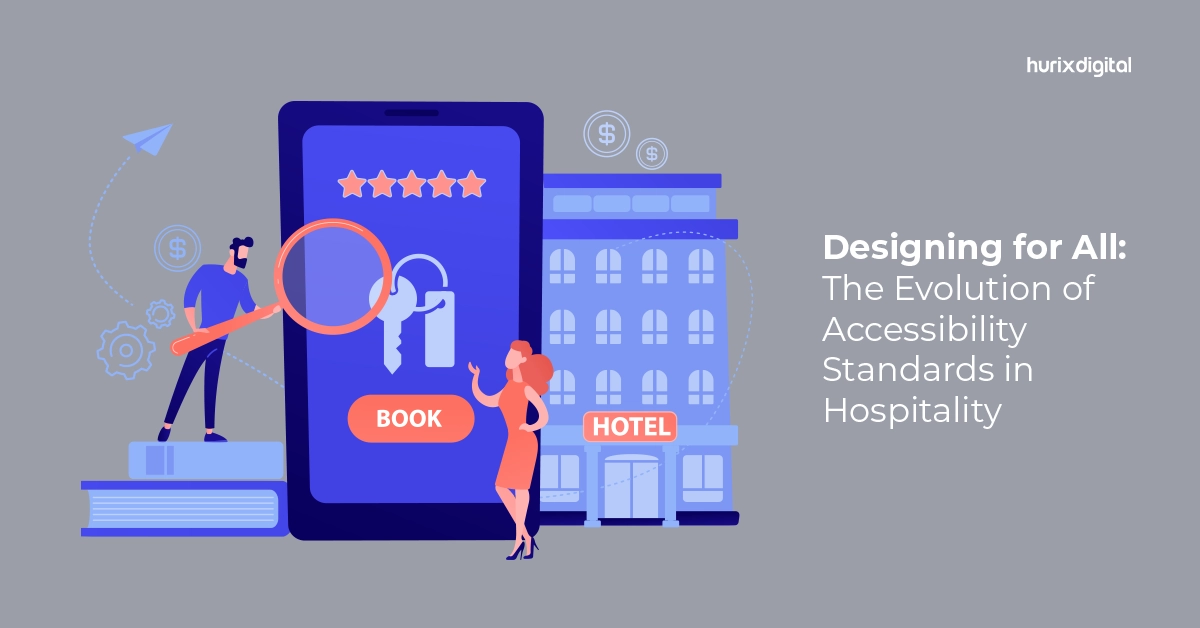
Designing for All: The Evolution of Accessibility Standards in Hospitality
Summary
Explore how accessibility standards in the hospitality industry have evolved. This article highlights key changes and how they contribute to a more inclusive guest experience.
In this digital era, before someone even enters a hotel room they prefer to research about the hotel and its facilities online. As per a survey shared by The Caterer, around 30% of surveyees claim that they would leave a venue immediately if it has inadequate accessibility for the disabled, while another 53% said they would not return to a venue if access was difficult.
Naturally, it has become extremely important to incorporate inclusive design practices to improve the customer experience in the hospitality industry. As per hospitality industry regulations, accessible accommodations are strictly monitored in many countries. With adaptive hospitality design, you can easily offer hospitality accessibility solutions to your customers.
In this blog, we will take you through the evolution of general accessibility standards over the decades, and look at ADA compliance in hotels in today’s time. We will explore the evolved hospitality accessibility standards and how digital accessibility impacts the hospitality sector.
Table of Contents:
- Evolution of Accessibility Standards – The Roadmap So Far
- Achieving ADA Compliance in Hotels
- A Deep Dive to Hospitality Accessibility Standards
- Impact of Digital Accessibility in the Hospitality Sector
- Conclusion
Evolution of Accessibility Standards – The Roadmap So Far
Accessibility standards have evolved a lot over time. Today, people are much more aware and mindful of being inclusive. Let’s take a look at some laws over the ages that have helped create more accessible spaces, both online and offline.
Here are some of the Accessibility Acts, year-wise, as they evolved.
- 1968 — The Architectural Barriers Act of 1968, ensured that there were no barriers at the entrance of any federal buildings.
- 1970 — The Urban Mass Transportation Act asked for every public vehicle to have wheelchair lift facilities.
- 1973 — The Rehabilitation Act prohibited discrimination against anyone with physical disabilities, in programs conducted by federal agencies.
- 1982 — The Telecommunications for the Disabled Act ensured telecommunication equipment was manufactured in such a way that they were accessible to those with disabilities.
- 1990 — The Americans with Disabilities Act is considered to be one of the most groundbreaking acts in this regard. It prohibits discrimination against the disabled, especially in areas such as employment, public accommodations (including hospitality), transportation, communications, and government access.
These acts have helped people with disabilities access various spaces, including spaces in the hospitality sector.
Also Read: Challenges of Designing and Developing Effective Enterprise Training
Achieving ADA Compliance in Hotels
In this digital era, the ADA, or the American Disability Act ensures that websites and other digital portals are accessible to people with disabilities. Since hotels and other institutions in the hospitality sector need to be compliant with these acts to be accessible to all patrons, they need to make sure that their websites are easily accessible to those with visual, auditory, motor, or cognitive impairments.
- Easy Website Navigation: Your website should be easily navigable. It should be clutter-free and simple to use. The content should have clear headings and labels with easy instructions.
- Contrasting Visuals: The text and background colors should be contrasting with one another to be easily perceivable.
- Alt Text: Include alternative texts for images. Even if someone can’t read it, this will allow screen-readers to read it out loud for the user to understand each image.
- Audio video content: Audio video content should be accompanied by transcripts and captions. This will help those with auditory as well as visual impairments to understand.
Readability: Use charts and graphs to explain content. Summarize the entire content using simple language. Try to avoid jargon while explaining.
A Deep Dive to Hospitality Accessibility Standards
The majority of travelers today rely on digital platforms to search or book hotels. Hence it has become even more important to comply with hospitality accessibility standards not just physically but also digitally, to improve conversion rates. Let us look at some of the steps you can take:
1. Regular Audit for Web Accessibility
First things first, get your websites tested regularly. Unless you regularly test for accessibility standards of your hotel portals, especially your booking portal, and update them as per the latest WCAG guidelines, you are losing out on a major business potential.
2. Keyboard Accessibility in the Reservation System
Several people with motor disabilities tend to use keyboards more to surf the internet. Using a mouse can be difficult for them. Hence, it is easier for them to scroll and navigate via keyboards. If your website is not accessible via keyboard alone then chances are higher that they might skip booking at your hotels.
3. Display Information About Your Accessibility Standards
Having accessible rooms and amenities is not enough. You have to make sure that you display every information about your accessibility online as well as offline. If someone wants to know whether your hotel has accessible rooms or not they should easily find the information on your portal and lounges.
4. Be Mindful While Using Colors and Images
Ensure that you meet the WCAG requirements for color contrast. If your text has a low contrast it can be a problem for many with color blindness to read them. Again the texts should not even be over-glaring to trigger seizures for some. It should maintain just the right contrast levels.
Impact of Digital Accessibility in the Hospitality Sector
Digital Accessibility is defined by the ease of access a disabled person experiences while accessing and navigating your websites, portals, mobile applications, or any other digital platforms.
Let us look at some of the direct impacts it has on your business:
- Ensures Legal Compliance: Yes, if not for anything else, Digital Accessibility can save you against a hefty lawsuit filing. Several countries came up with regulatory laws to mandate digital accessibility. ADA or the Americans Disability Act is one such act that demands compliance.
- Increased Market Reach: A digitally accessible portal can widen your market reach by a significant margin. Almost 16% of the world’s population experience some form of significant disabilities. Which is 1 in every 6 of us may need digitally accessible portals for traveling and booking.
- Improved Brand Image: As a hospitality brand, promoting a culture of inclusivity can build your brand image. It is a welcoming gesture towards everyone without any discrimination or bias.
Also Read: Designing Effective Application Training Programs for Healthcare Professionals
Conclusion
Accessibility in the hospitality sector demands more attention day by day. It promotes an inclusive culture and is the only way forward. It is not only ethically correct but also legally and financially beneficial. It can widen your market reach, improve your customer satisfaction as well as help build your brand image, giving you a clear edge over your competitors.
With decades of experience and expertise, Hurix Digital comes as a one-stop solution for your accessibility requirements. Be it auditing your websites and portals, or transforming them into digitally accessible as per the latest WCAG guideline, we are there for you. Contact us now and get your portals accessible right away.

Vice President – Digital Content Transformation. He is PMP, CSM, and CPACC certified and has 20+ years of experience in Project Management, Delivery Management, and managing the Offshore Development Centre (ODC).



